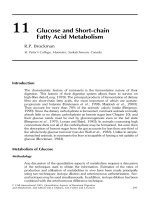Tài liệu An overview of customer satisfaction and loyalty doc
Bạn đang xem bản rút gọn của tài liệu. Xem và tải ngay bản đầy đủ của tài liệu tại đây (457.96 KB, 5 trang )
An Overview of
Customer Satisfaction and Loyalty
Prepared by:
Joe Jennings
Vice President
Why is customer satisfaction and loyalty research important?
Customer satisfaction and loyalty research allows your customers to communicate with
you directly about their needs, assuring you that the quality standards you establish
reflect the voice of the customer and not just the company line. This research can help
you:
• Learn about your strengths and weaknesses.
• Allocate resources for optimal impact and satisfaction.
• Indicate your seriousness about improving quality of products and services to both
your employees and your customers.
• Determine competitive strengths and weaknesses.
• Gain additional insight into the sources of dissatisfaction and areas requiring
improvement.
• Provide a system for informing management of problems or situations requiring
immediate attention.
What is the customer satisfaction measurement process?
Because everyone’s needs are different, a specific approach is developed to meet them.
However, the overall process can be divided into six interactive phases.
Customer Satisfaction Measurement Process
Phase 6: Tracking
Provide Ongoing Quantitative
Assessment of Performance
Deliver Easy-to-
Understand Reports to
Employees/Management
Phase 5: Implementation
Implement Plans
Phase 1: Mobilization
Define Business and
Information Objectives
Develop Overall Plan
Gain Management Commitment
Phase 2: Discovery
Identify
• Needs/Expectations
• Types of Problems
• Points of
Customers/Company
Interaction
Conduct Qualitative Research
Survey Customers/Employees
Phase 3: Needs and Performance Evaluation
Provide Quantitative Measures of:
• Importance of Key Attributes
• Company Performance on Key Attributes
• Competitive Performance
• Expectations of Specific Levels of
Performance
Determine Areas of Greatest Impact
Phase 4: Action Planning
Identify Teams
Identify Research Implications:
• Changes in Product/Services
• Internal Processes
• Development of New Product/
Services
• Training
Set Customer Driven Standards
Create Detailed Plans
What is the best way for me to determine what’s important to my
customers?
We believe that there is no single best way to assess the relative importance of specific
aspects of performance and that the choice of a method depends on your particular
needs. There are several approaches:
• Multiple Paired Comparisons – This technique avoids the problem of little
differentiation among attributes and allows customers to make trade-offs regarding
the importance of specific attributes the same way they would evaluate products or
services in the real world.
• Constant Sum –In this method, customers are asked to apportion some number of
points, generally 10 to 100, that reflect their relative importance in determining
overall satisfaction.
• Competitive Leverage Map – This map integrates both importance and
performance information to identify areas of competitive strength and weakness.
• Regression Analysis – This is a useful method for assessing the relative
importance of attributes when customers are unable or unwilling to directly state their
views. It examines the extent to which the satisfaction or performance ratings the
customers give the company on each of the attributes are related to customers’
overall satisfaction.
• Key Driver Analysis – This method quantifies the relationship between 1) the key
drivers and satisfaction and 2) satisfaction and a business outcome. This analysis
suggests where to allocate resources to get the best return on investments.
• Structural Equation Modeling – Thus is a sophisticated structural model
development process that takes into account, and quantifies, the interplay of
attributes on one another in driving or influencing the satisfaction of customers.
How do I use this information to improve customer satisfaction?
A well designed customer satisfaction approach can eliminate much of the guesswork
regarding how customer satisfaction directly affects business outcomes. It can provide
direct estimates of the bottom line improvements you’ll achieve from specific increases
in satisfaction levels.
• A Customer Satisfaction program helps you determine:
Key drivers of satisfaction
Items that make the greatest contribution to the driver
Components of the driver that should be invested in
Overall level of satisfaction
Overall satisfaction level’s effect on business outcomes
• Strategic analysis identifies critical areas for improvement
High priority
Potential resources for reallocation
Leverage opportunities
Low priority
• Identifying specific levels of performance helps you set targets and establish key
indicators letting you:
Allocate resources effectively
Focus on objectives congruent with customers’ expectations
How do I move customers beyond customer satisfaction to loyalty?
There is a complex relationship between satisfaction and loyalty. Satisfaction is the first
tier in the relationship between a customer and the company. In order for a company to
differentiate itself from the competition, it will have to move customers from the first tier
of this relationship, satisfaction, to the second tier, loyalty.
A loyalty model incorporates both behavioral as well as psychological components to
compute a loyalty index. The results of this loyalty index are then used to create market
segments that classify customers’ current relationships with the company. Customers
will be grouped into segments based on their level of comfort with their relationship with
the company. These results are very strategic for the company because they alert the
company to potential departing customers. A similar index can be developed for
potential customers. This index classifies customers based on their likelihood to switch
from their current company to your company. Again this is very strategic for the
company because this can be used to decide where to allocate marketing and
advertising resources to convert potential customers into customers.









